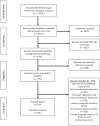Quality and acceptability of measures of exercise adherence in musculoskeletal settings: a systematic review
- PMID: 28013200
- PMCID: PMC5410983
- DOI: 10.1093/rheumatology/kew422
Quality and acceptability of measures of exercise adherence in musculoskeletal settings: a systematic review
Abstract
Objective: To recommend robust and relevant measures of exercise adherence for application in the musculoskeletal field.
Method: A systematic review of measures was conducted in two phases. Phase 1 sought to identify all reproducible measures used to assess exercise adherence in a musculoskeletal setting. Phase 2 identified published evidence of measurement and practical properties of identified measures. Eight databases were searched (from inception to February 2016). Study quality was assessed against the Consensus-based Standards for the Selection of Health Measurement Instruments guidelines. Measurement quality was assessed against accepted standards.
Results: Phase 1: from 8511 records, 326 full-text articles were reviewed; 45 reproducible measures were identified. Phase 2: from 2977 records, 110 full-text articles were assessed for eligibility; 10 articles provided evidence of measurement/practical properties for just seven measures. Six were exercise adherence-specific measures; one was specific to physical activity but applied as a measure of exercise adherence. Evidence of essential measurement and practical properties was mostly limited or not available. Assessment of relevance and comprehensiveness was largely absent and there was no evidence of patient involvement during the development or evaluation of any measure.
Conclusion: The significant methodological and quality issues encountered prevent the clear recommendation of any measure; future applications should be undertaken cautiously until greater clarity of the conceptual underpinning of each measure is provided and acceptable evidence of essential measurement properties is established. Future research should seek to engage collaboratively with relevant stakeholders to ensure that exercise adherence assessment is high quality, relevant and acceptable.
Keywords: acceptability; adherence; exercise; measurement; musculoskeletal; physical activity; quality; systematic review.
© The Author 2016. Published by Oxford University Press on behalf of the British Society for Rheumatology.
Figures
References
-
- United States Bone and Joint Initiative. The Burden of Musculoskeletal Diseases in the United States. 2014. http://www.boneandjointburden.org/2014-report (16 May 2016, date last accessed).
-
- Hoy DG, Smith E, Cross M. et al. Reflecting on the global burden of musculoskeletal conditions: Lessons learnt from the global burden of disease 2010 study and the next steps forward. Ann Rheum Dis 2015;74:4–7. - PubMed
-
- Walsh NE, Brooks P, Hazes JM. et al. Standards of care for acute and chronic musculoskeletal pain: The bone and joint decade (2000–2010). Arch Phys Med Rehabil 2008;89:1830–45. - PubMed
-
- Reginster JY. The prevalence and burden of arthritis. Rheumatology 2002;41(Suppl 1):3–6. - PubMed
Publication types
MeSH terms
LinkOut - more resources
Full Text Sources
Other Literature Sources



